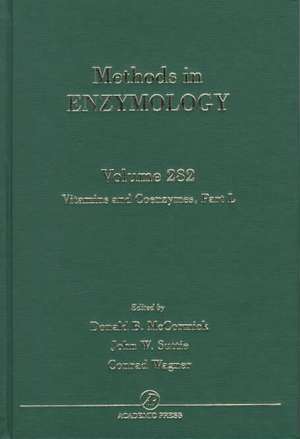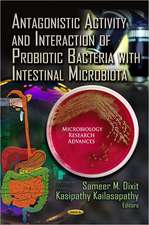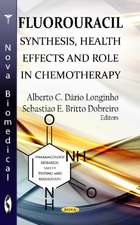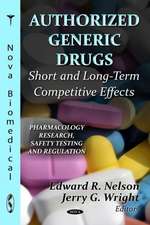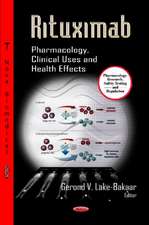Vitamins and Coenzymes, Part L: Methods in Enzymology, cartea 282
Edward A. Dennis, Melvin I. Simon Donald B. McCormick, John W. Suttie, Conrad Wagneren Limba Engleză Hardback – 18 oct 1997
- This volume and its companion Volumes 279, 280, and 281
- A collation of the most recent and useful methods for the identification, preparation, and quantification of vitamins and coenzymes
- Details on physical, chemical, and biological properties of vitamins and coenzymes
- Chemical and biological syntheses of vitamins, coenzymes, and their analogs
- Aspects of transport and metabolism of vitamins and coenzymes
Din seria Methods in Enzymology
- 32%
 Preț: 802.54 lei
Preț: 802.54 lei - 23%
 Preț: 461.36 lei
Preț: 461.36 lei - 23%
 Preț: 460.60 lei
Preț: 460.60 lei - 23%
 Preț: 439.86 lei
Preț: 439.86 lei - 23%
 Preț: 448.15 lei
Preț: 448.15 lei - 23%
 Preț: 451.42 lei
Preț: 451.42 lei - 23%
 Preț: 445.18 lei
Preț: 445.18 lei - 5%
 Preț: 557.15 lei
Preț: 557.15 lei - 23%
 Preț: 450.67 lei
Preț: 450.67 lei - 23%
 Preț: 446.23 lei
Preț: 446.23 lei - 23%
 Preț: 435.87 lei
Preț: 435.87 lei - 23%
 Preț: 445.94 lei
Preț: 445.94 lei - 23%
 Preț: 459.55 lei
Preț: 459.55 lei - 23%
 Preț: 460.02 lei
Preț: 460.02 lei - 23%
 Preț: 456.61 lei
Preț: 456.61 lei - 23%
 Preț: 450.54 lei
Preț: 450.54 lei - 23%
 Preț: 453.47 lei
Preț: 453.47 lei - 5%
 Preț: 565.37 lei
Preț: 565.37 lei - 23%
 Preț: 450.67 lei
Preț: 450.67 lei - 23%
 Preț: 464.33 lei
Preț: 464.33 lei - 23%
 Preț: 441.49 lei
Preț: 441.49 lei - 23%
 Preț: 447.44 lei
Preț: 447.44 lei - 23%
 Preț: 459.13 lei
Preț: 459.13 lei - 23%
 Preț: 450.38 lei
Preț: 450.38 lei - 23%
 Preț: 445.80 lei
Preț: 445.80 lei - 23%
 Preț: 445.35 lei
Preț: 445.35 lei - 23%
 Preț: 442.53 lei
Preț: 442.53 lei - 23%
 Preț: 450.38 lei
Preț: 450.38 lei - 23%
 Preț: 448.60 lei
Preț: 448.60 lei - 23%
 Preț: 447.57 lei
Preț: 447.57 lei - 23%
 Preț: 458.97 lei
Preț: 458.97 lei - 23%
 Preț: 440.90 lei
Preț: 440.90 lei - 23%
 Preț: 448.15 lei
Preț: 448.15 lei - 23%
 Preț: 466.84 lei
Preț: 466.84 lei - 23%
 Preț: 451.42 lei
Preț: 451.42 lei - 23%
 Preț: 453.64 lei
Preț: 453.64 lei - 23%
 Preț: 459.13 lei
Preț: 459.13 lei - 23%
 Preț: 457.49 lei
Preț: 457.49 lei - 23%
 Preț: 447.44 lei
Preț: 447.44 lei - 5%
 Preț: 561.34 lei
Preț: 561.34 lei - 23%
 Preț: 447.57 lei
Preț: 447.57 lei - 23%
 Preț: 453.35 lei
Preț: 453.35 lei - 23%
 Preț: 441.95 lei
Preț: 441.95 lei - 23%
 Preț: 450.38 lei
Preț: 450.38 lei - 23%
 Preț: 449.19 lei
Preț: 449.19 lei - 23%
 Preț: 456.02 lei
Preț: 456.02 lei - 23%
 Preț: 455.11 lei
Preț: 455.11 lei - 23%
 Preț: 455.87 lei
Preț: 455.87 lei - 23%
 Preț: 451.12 lei
Preț: 451.12 lei
Preț: 1162.27 lei
Preț vechi: 1592.15 lei
-27% Nou
Puncte Express: 1743
Preț estimativ în valută:
222.42€ • 230.81$ • 185.91£
222.42€ • 230.81$ • 185.91£
Carte tipărită la comandă
Livrare economică 17-31 martie
Preluare comenzi: 021 569.72.76
Specificații
ISBN-13: 9780121821838
ISBN-10: 0121821838
Pagini: 505
Dimensiuni: 152 x 229 x 28 mm
Greutate: 0.88 kg
Editura: ELSEVIER SCIENCE
Seria Methods in Enzymology
ISBN-10: 0121821838
Pagini: 505
Dimensiuni: 152 x 229 x 28 mm
Greutate: 0.88 kg
Editura: ELSEVIER SCIENCE
Seria Methods in Enzymology
Public țintă
Biochemists, nutritionists, cell biologists, pharmacologists, molecular biologists, and physiologists.Cuprins
Vitamin A:
A.W. Norris and E. Li, Generation and Characterization of Cellular Retinoic Acid-Binding Proteins from Escherichia coli Expression System.
M. Clagett-Dame and J.J. Repa, Generating and Characterizing Retinoid Receptors from Escherichia coli and Insect Cell Expression Systems.
E.A. Allegretto and R.A. Heyman, Expression and Characterization of Retinoid Receptors in Yeast.
A. Rowe and P.M. Brickell, Use of in Situ Hybridization Techniques to Study Embryonic Expression of Retinoid Receptors and Binding Proteins.
N. Ferrari, G. Vidali, and U. Pfeffer, Use of Quantitative PCR to Study Retinoid Receptor Expression.
L. Zhou, G. Otulakowski, and C.Y. Lau, Use of Quantitative PCR to Study Cellular Retinoic Acid Binding Protein-II mRNA Expression in Human Skin.
L. Wojnowski and A. Zimmer, Use of Transgenic Mice to Study Activation of Retinoic Acid-Responsive Promoters.
M. Saitou, T. Tanaka, and A. Kakizuka, Use of Transgenic Mice to Eliminate Retinoic Acid Receptor Function in Specific Tissues.
M. Wagner, Use of Reporter Cells to Study Endogenous Retinoid Sources in Embryonic Tissues.
P.K. Tadikonda and H.F. DeLuca, Preparation of Radiolabeled9-cis- and all-trans-Retinoids.
X-D. Wang and N.I. Krinsky, Identification and Quantification of Retinoic Acid and Other Metabolites from (-Carotene Excentric Cleavage in Human Intestine in Vitro and Ferret Intestine in Vivo.
R.S. Parker, J.T. Brenna, J.E. Swanson, K.J. Goodman, and B. Marmor, Assessing Metabolism of (-[13C] Carotene Using High Precision Isotope Ratio Mass Spectrometry. G. Tang, B.A. Andrien, G.G. Donikowski, and R.M. Russell, Atmospheric Pressure Chemical Ionization and Electron Capture Negative Chemical Ionization Mass Spectrometry in Studying (-Carotene Conversion to Retinol in Humans.
Vitamin D:
R. Ray and M.F. Holick, Synthesis of [3(-3H]Vitamin D3 and 1(,25-Dihydroxy[1(-3H]Vitamin D3.
M.J. Beckman and H.F. DeLuca, Assay of 1,25-Dihydroxyvitamin D3 from Serum Samples: Use of Receptor Binding or Enzyme Coupled Reporter Analysis.
B.W. Hollis, Quantitation of 25-Hydroxyvitamin D and 1,25-Dihydroxyvitamin D by Radioimmunoassay Using Radioiodinated Tracers.
Y. Ohyama, S-I. Hayashi, E. Usui, M. Noshiro, and K-I. Okuda, Assay of Vitamin D Derivatives and Purification of Vitamin D Hydroxylases.
M.J. Beckman and H.F. DeLuca, Assay of25-Hydroxyvitamin D 1(-Hydroxylase and 24-Hydroxylase.
M. Noshiro, Y. Ohyama, E. Usui, M. Akiyoshi-Shibata, Y. Yabusaki, and K-I. Okuda, Molecular Cloning of Vitamin D3 Hydroxylases.
T. Suda, E. Jimi, I. Nakamura, and N. Takahashi, Role of 1(,25-Dihydroxyvitamin D3 in Osteoclast Differentiation and Function.
J.G. Meszaros and M.C. Farach-Carson, Assay of Direct Effect of 1,25-Dihydroxyvitamin D3 on Calcium Ion Influx into Cultured Osteoblasts.
Vitamin E:
A. Beharka, S. Redican, L. Leka, and S.N. Meydani, Vitamin E Status and Immune Function.
M. Steiner, Inhibition of Platelet Adhesion as Functional Test for Vitamin E Status.
N. Noguchi and E. Niki, Inhibition of Plasma Cholesterol Ester Hydroperoxide and Phosphatidylcholine Hydroperoxide Formation as Measures of Antioxidant Status.
A.K. Dutta-Roy, (-Tocopherol-Binding Proteins: Purification and Characterization.
M. Schultz, M. Leist, A. Elsner, and R. Brigelius-Flohe, (-Carboxyethyl-6-hydroxychroman as Urinary Metabolite of Vitamin E.
Vitamin K:
K.L. Berkner and B.A. McNally, Purification of Vitamin K-Dependent Carboxylase from Cultured Cells.
B.C. Furie, A. Kuliopulos, D.A. Roth, I. Sugiura, C.T. Walsh, and B. Furie, Purification of Native Bovine Carboxylase and Expression and Purification of Recombinant Bovine Carboxylase.
S-M. Wu, V.P. Mutucumarana, and D.W. Stafford, Purification of (-Glutamyl Carboxylase from Bovine Liver.
R.J.T.J. Houben, B.A.M. Soute,and C. Vermeer, Assay of Vitamin K-Dependent Carboxylase Activity in Hepatic and Extrahepatic Tissues.
F.J. Castellino and J-P. Geng, Expression of Human Anticoagulation Protein C and (-Carboxyglutamic Acid Mutants in Mammalian Cell Cultures.
M.E. Benton and J.W. Suttie, Determination of Site-Specific (-Carboxyglutamic Formation by Vitamin K-Dependent Carboxylase Utilizing De-(-Carboxy Bone Gla Protein as Substrate.
R. Wallin and T.M. Guenthner, Purification of Warfarin-Sensitive Vitamin K Epoxide Reductase.
K.W. Davidson and J.A. Sadowski, Determination of Vitamin K Compounds in Plasma or Serum by High-Performance Liquid Chromatography Using Postcolumn Chemical Reduction and Fluorimetric Detection.
P.T. McCarthy, D.L. Harrington, and M.J. Shearer, Assay of Phylloquinone in Plasma by High-Performance Liquid Chromatography with Electrochemical Detection.
S.J. Hodges, Assay of Menaquinones in Plasma Utilizing Dual-Electrode Electrochemical Detection.
Y. Usui, Assay of Phylloquinone and Menaquinones in Human Liver.
S.L. Booth and J.A. Sadowski, Determination of Phylloquinone in Foods by High-Performance Liquid Chromatography.
J.M. Conly, Assay of Menaquinones in Bacterial Cultures, Stool Samples, and Intestinal Cultures.
Author Index.
Subject Index.
A.W. Norris and E. Li, Generation and Characterization of Cellular Retinoic Acid-Binding Proteins from Escherichia coli Expression System.
M. Clagett-Dame and J.J. Repa, Generating and Characterizing Retinoid Receptors from Escherichia coli and Insect Cell Expression Systems.
E.A. Allegretto and R.A. Heyman, Expression and Characterization of Retinoid Receptors in Yeast.
A. Rowe and P.M. Brickell, Use of in Situ Hybridization Techniques to Study Embryonic Expression of Retinoid Receptors and Binding Proteins.
N. Ferrari, G. Vidali, and U. Pfeffer, Use of Quantitative PCR to Study Retinoid Receptor Expression.
L. Zhou, G. Otulakowski, and C.Y. Lau, Use of Quantitative PCR to Study Cellular Retinoic Acid Binding Protein-II mRNA Expression in Human Skin.
L. Wojnowski and A. Zimmer, Use of Transgenic Mice to Study Activation of Retinoic Acid-Responsive Promoters.
M. Saitou, T. Tanaka, and A. Kakizuka, Use of Transgenic Mice to Eliminate Retinoic Acid Receptor Function in Specific Tissues.
M. Wagner, Use of Reporter Cells to Study Endogenous Retinoid Sources in Embryonic Tissues.
P.K. Tadikonda and H.F. DeLuca, Preparation of Radiolabeled9-cis- and all-trans-Retinoids.
X-D. Wang and N.I. Krinsky, Identification and Quantification of Retinoic Acid and Other Metabolites from (-Carotene Excentric Cleavage in Human Intestine in Vitro and Ferret Intestine in Vivo.
R.S. Parker, J.T. Brenna, J.E. Swanson, K.J. Goodman, and B. Marmor, Assessing Metabolism of (-[13C] Carotene Using High Precision Isotope Ratio Mass Spectrometry. G. Tang, B.A. Andrien, G.G. Donikowski, and R.M. Russell, Atmospheric Pressure Chemical Ionization and Electron Capture Negative Chemical Ionization Mass Spectrometry in Studying (-Carotene Conversion to Retinol in Humans.
Vitamin D:
R. Ray and M.F. Holick, Synthesis of [3(-3H]Vitamin D3 and 1(,25-Dihydroxy[1(-3H]Vitamin D3.
M.J. Beckman and H.F. DeLuca, Assay of 1,25-Dihydroxyvitamin D3 from Serum Samples: Use of Receptor Binding or Enzyme Coupled Reporter Analysis.
B.W. Hollis, Quantitation of 25-Hydroxyvitamin D and 1,25-Dihydroxyvitamin D by Radioimmunoassay Using Radioiodinated Tracers.
Y. Ohyama, S-I. Hayashi, E. Usui, M. Noshiro, and K-I. Okuda, Assay of Vitamin D Derivatives and Purification of Vitamin D Hydroxylases.
M.J. Beckman and H.F. DeLuca, Assay of25-Hydroxyvitamin D 1(-Hydroxylase and 24-Hydroxylase.
M. Noshiro, Y. Ohyama, E. Usui, M. Akiyoshi-Shibata, Y. Yabusaki, and K-I. Okuda, Molecular Cloning of Vitamin D3 Hydroxylases.
T. Suda, E. Jimi, I. Nakamura, and N. Takahashi, Role of 1(,25-Dihydroxyvitamin D3 in Osteoclast Differentiation and Function.
J.G. Meszaros and M.C. Farach-Carson, Assay of Direct Effect of 1,25-Dihydroxyvitamin D3 on Calcium Ion Influx into Cultured Osteoblasts.
Vitamin E:
A. Beharka, S. Redican, L. Leka, and S.N. Meydani, Vitamin E Status and Immune Function.
M. Steiner, Inhibition of Platelet Adhesion as Functional Test for Vitamin E Status.
N. Noguchi and E. Niki, Inhibition of Plasma Cholesterol Ester Hydroperoxide and Phosphatidylcholine Hydroperoxide Formation as Measures of Antioxidant Status.
A.K. Dutta-Roy, (-Tocopherol-Binding Proteins: Purification and Characterization.
M. Schultz, M. Leist, A. Elsner, and R. Brigelius-Flohe, (-Carboxyethyl-6-hydroxychroman as Urinary Metabolite of Vitamin E.
Vitamin K:
K.L. Berkner and B.A. McNally, Purification of Vitamin K-Dependent Carboxylase from Cultured Cells.
B.C. Furie, A. Kuliopulos, D.A. Roth, I. Sugiura, C.T. Walsh, and B. Furie, Purification of Native Bovine Carboxylase and Expression and Purification of Recombinant Bovine Carboxylase.
S-M. Wu, V.P. Mutucumarana, and D.W. Stafford, Purification of (-Glutamyl Carboxylase from Bovine Liver.
R.J.T.J. Houben, B.A.M. Soute,and C. Vermeer, Assay of Vitamin K-Dependent Carboxylase Activity in Hepatic and Extrahepatic Tissues.
F.J. Castellino and J-P. Geng, Expression of Human Anticoagulation Protein C and (-Carboxyglutamic Acid Mutants in Mammalian Cell Cultures.
M.E. Benton and J.W. Suttie, Determination of Site-Specific (-Carboxyglutamic Formation by Vitamin K-Dependent Carboxylase Utilizing De-(-Carboxy Bone Gla Protein as Substrate.
R. Wallin and T.M. Guenthner, Purification of Warfarin-Sensitive Vitamin K Epoxide Reductase.
K.W. Davidson and J.A. Sadowski, Determination of Vitamin K Compounds in Plasma or Serum by High-Performance Liquid Chromatography Using Postcolumn Chemical Reduction and Fluorimetric Detection.
P.T. McCarthy, D.L. Harrington, and M.J. Shearer, Assay of Phylloquinone in Plasma by High-Performance Liquid Chromatography with Electrochemical Detection.
S.J. Hodges, Assay of Menaquinones in Plasma Utilizing Dual-Electrode Electrochemical Detection.
Y. Usui, Assay of Phylloquinone and Menaquinones in Human Liver.
S.L. Booth and J.A. Sadowski, Determination of Phylloquinone in Foods by High-Performance Liquid Chromatography.
J.M. Conly, Assay of Menaquinones in Bacterial Cultures, Stool Samples, and Intestinal Cultures.
Author Index.
Subject Index.
Recenzii
Praise for the Series
"The Methods in Enzymology series represents the gold-standard." --NEUROSCIENCE
"Incomparably useful." --ANALYTICAL BIOCHEMISTRY
"It is a true 'methods' series, including almost every detail from basic theory to sources of equipment and reagents, with timely documentation provided on each page." --BIO/TECHNOLOGY
"The series has been following the growing, changing and creation of new areas of science. It should be on the shelves of all libraries in the world as a whole collection." --CHEMISTRY IN INDUSTRY
"The appearance of another volume in that excellent series, Methods in Enzymology, is always a cause for appreciation for those who wish to successfully carry out a particular technique or prepare an enzyme or metabolic intermediate without the tiresome prospect of searching through unfamiliar literature and perhaps selecting an unproven method which is not easily reproduced." --AMERICAN SOCIETY OF MICROBIOLOGY NEWS
"If we had some way to find the work most often consulted in the laboratory, it could well be the multi-volume series Methods in Enzymology...a great work." --ENZYMOLOGIA
"A series that has established itself as a definitive reference for biochemists." --JOURNAL OF CHROMATOGRAPHY
"The Methods in Enzymology series represents the gold-standard." --NEUROSCIENCE
"Incomparably useful." --ANALYTICAL BIOCHEMISTRY
"It is a true 'methods' series, including almost every detail from basic theory to sources of equipment and reagents, with timely documentation provided on each page." --BIO/TECHNOLOGY
"The series has been following the growing, changing and creation of new areas of science. It should be on the shelves of all libraries in the world as a whole collection." --CHEMISTRY IN INDUSTRY
"The appearance of another volume in that excellent series, Methods in Enzymology, is always a cause for appreciation for those who wish to successfully carry out a particular technique or prepare an enzyme or metabolic intermediate without the tiresome prospect of searching through unfamiliar literature and perhaps selecting an unproven method which is not easily reproduced." --AMERICAN SOCIETY OF MICROBIOLOGY NEWS
"If we had some way to find the work most often consulted in the laboratory, it could well be the multi-volume series Methods in Enzymology...a great work." --ENZYMOLOGIA
"A series that has established itself as a definitive reference for biochemists." --JOURNAL OF CHROMATOGRAPHY
